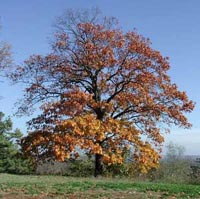Resource Library
Plant of the Week: Red Oak Borer
The University of Arkansas System Division of Agriculture does not promote, support or recommend plants featured in "Plant of the Week." Please consult your local Extension office for plants suitable for your region.
Plant of the Week
Red Oak Borer

We are all Nature lovers, but the love affair oftentimes seems decidedly one-sided, for Mother Nature shows no favoritism in her love. She doesn’t especially care what we want and frequently seems a bit miffed by our need for control. Sometimes, as in the recent outbreak of red oak borer in the Ozark National Forest, we are tested to see if we really do love Nature in all its varied forms.
The first large-scale die off of oaks was reported in the summer of 1999 on Woods Mountain north of Clarksville. Since then, more than 20,000 acres of forest land – mainly in the southern Ozarks but also scattered in the Ouachitas near Mena and in Oklahoma - have been attacked as the borer population mushroom.
The red oak borer epidemic is, to a large measure, a product of our own making. Our management of the woodland resources of the Ozarks has been meager. A century ago, most of the original oak forest was cut to satisfy the insatiable demand for railroad ties as the country went through its industrial expansion after the Civil War.
When the forest grew back, all of the trees started growing within a span of about 10 years. Trees from better sites grew faster and began to be harvested from these second-growth stands after 50 or 60 years. But much of the terrain of the Ozarks contains shallow, rocky soils and trees needed a century to attain the kind of stature that attracts timber buyers.
Herein lies a problem. Red oaks typically have a life span of 100 to 150 years. Under ideal conditions, the older number applies; under stressful conditions the younger number becomes the norm. Because the Ozark forest is primarily a monoculture of oaks, competition between individuals is keen. Throw drought, intense competition and an even-age forest of advanced age into the equation, and conditions are right for a corrective action.
The red oak borer has long been known and mostly considered a secondary pest by entomologists. As a minor pest, not much was known about the population dynamics of the insect. Dr. Fred Stephens, the chair of the UofA Entomology Department in Fayetteville, and Dr. Damon Crook, a post-doctoral assistant, have spearheaded efforts to understand the insect and the events driving the explosion.
Their initial work, a laborious task of cutting half-meter long samples of red oak logs, stripping the bark and then splitting the log, determined that the insect population was phenomenally high. Previous outbreaks in the 1970s had reported 72 borers per tree; the current outbreak was producing counts as high as 4200 insects per tree. The team has four graduate students currently studying various aspects of the problem.
The red oak borer is a brown, longhorn beetle about an inch long. It emerges as an adult only during odd numbered years and requires two years to complete its life cycle. Most old red and black oaks can survive a few borers with no ill effects, but they cannot survive a massive attack. Mass invasion causes the trees to be girdled, killing it in its second season of attack. If the borers stick to their expected schedule, the next adult emergence will be in July 2005.
According to Stephens, the red oak borer should not be a major problem in our landscapes. Urban settings have a more diverse mixture of trees than found in the forest, trees of different ages are usually present, and the stand density is lower, thus reducing the stress on the trees.
Also, urban trees often get watered during dry spells, further reducing the stress. For these reasons, the high borer populations should not occur in town trees so, for once, gardeners may dodge the bullet.
By: Gerald Klingaman, retired
Extension Horticulturist - Ornamentals
Extension News - March 12, 2004
The University of Arkansas System Division of Agriculture does not maintain lists of retail outlets where these plants can be purchased. Please check your local nursery or other retail outlets to ask about the availability of these plants for your growing area.